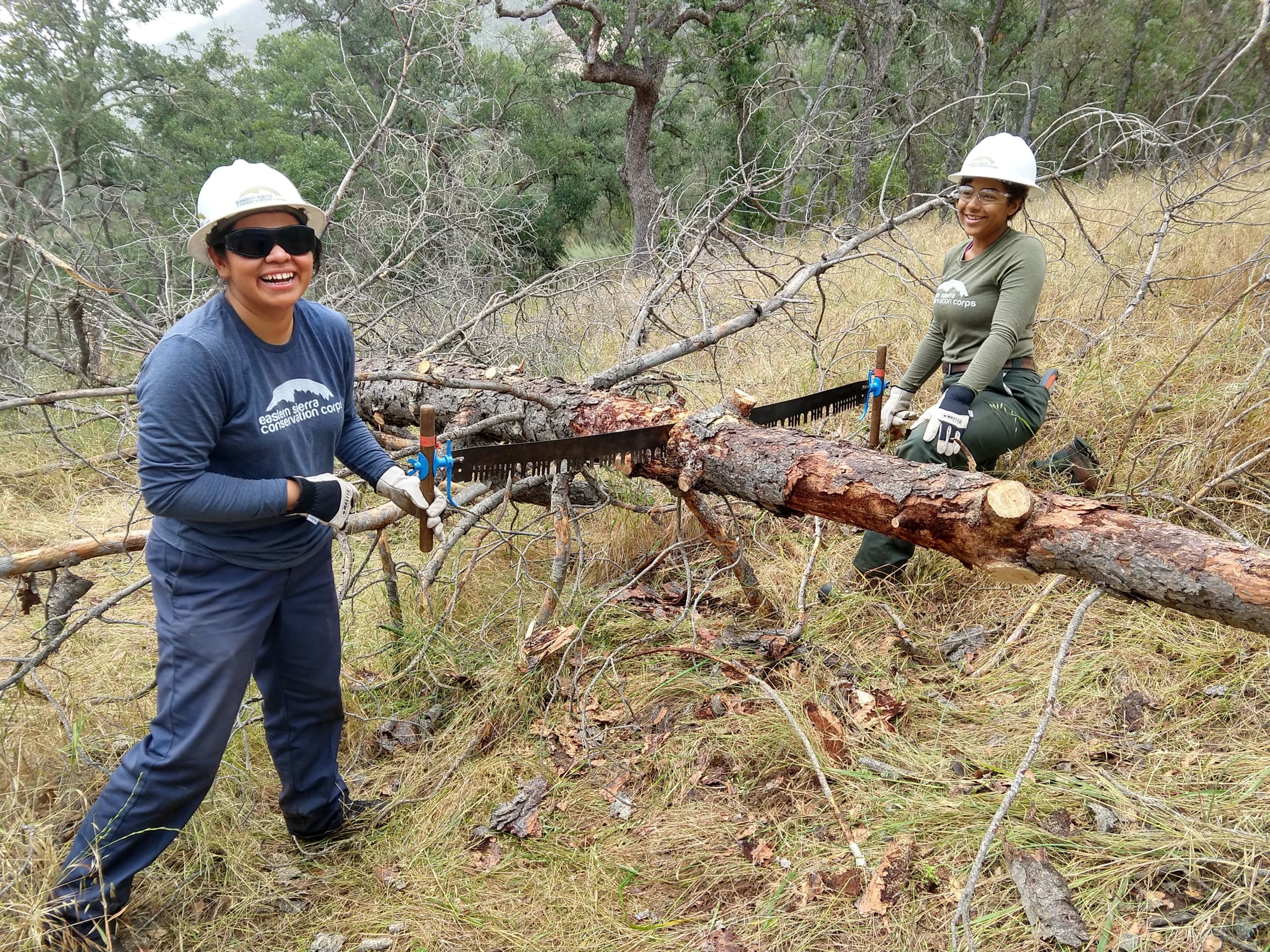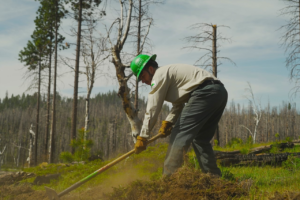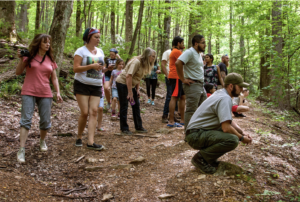Every year, Service and Conservation Corps work across the country to engage young adults and recent veterans in maintaining some of America’s most treasured natural and cultural resources. From restoring or building new backcountry trails, to planting trees and planting gardens in urban areas, Corpsmembers complete important projects to help make the outdoors accessible and sustainable. To celebrate Great Outdoors Month, we’re highlighting some of the many ways Corpsmembers #ServeOutdoors.
For even more ways Corpsmembers #ServeOutdoors, check out The Many Ways AmeriCorps Members #ServeOutdoors on the CNCS Website.
California
 Esmeralda Adame, 27, serves on trail projects with Eastern Sierra Conservation Corps. This isn’t her first outdoor service experience, however. When she served on the Backcountry Trails Program with the California Conservation Corps, Esmeralda participated in completing an ADA-accessible trail in Providence Mountains State Recreation Area. Along with her crewmates, Esmeralda helped ensure the trail was stable and had proper drainage.
Esmeralda Adame, 27, serves on trail projects with Eastern Sierra Conservation Corps. This isn’t her first outdoor service experience, however. When she served on the Backcountry Trails Program with the California Conservation Corps, Esmeralda participated in completing an ADA-accessible trail in Providence Mountains State Recreation Area. Along with her crewmates, Esmeralda helped ensure the trail was stable and had proper drainage.
“I’ve always wanted to work outdoors and learn about our environment, but I didn’t know where to begin. I saw an ad online for the California Conservation Corps and thought, ‘this is it!’ When I heard about the Backcountry Trails Program with AmeriCorps, I instantly knew it was going to change my life. Being in the wilderness for five and a half months in tough weather conditions, miles of hiking, and bonding with your crew, you come back to civilization with a stronger mindset.
This project was one of the toughest ones in my opinion. Hauling multiple chest-sized rocks in a wheelbarrow up to the worksite, [putting the rocks in place], and learning different styles of dry masonry was very rewarding for me after seeing visitors go along the trail with ease.
I believe other people should serve in the Great Outdoors because it’s rewarding and you get to enjoy beautiful sceneries wherever you go. There should be more people, especially youth, learning about our environment and how to respect the lives within the wilderness.”
 San Jose Conservation Corps (SJCC) members spent 10 days on the outskirts of Yosemite National Park conducting vital fire prevention operations. SJCC members trenched firebreaks, trimmed overgrowth, and cleared space for seedlings to flourish. Serving alongside their counterparts in the California Conservation Corps, members learned a host of skills in wildlife preservation, trail maintenance, and techniques for operating chainsaws and pole saws.
San Jose Conservation Corps (SJCC) members spent 10 days on the outskirts of Yosemite National Park conducting vital fire prevention operations. SJCC members trenched firebreaks, trimmed overgrowth, and cleared space for seedlings to flourish. Serving alongside their counterparts in the California Conservation Corps, members learned a host of skills in wildlife preservation, trail maintenance, and techniques for operating chainsaws and pole saws.
“Before I joined the San Jose Conservation Corps, I didn’t think much about the environment,” SJCC member Katie R. said. “But after having the opportunity to come to places like Yosemite and see how my work makes a difference for trees, plants and animals, I can’t get enough!”
Minnesota
 Corpsmembers with Conservation Corps Minnesota & Iowa helped clear vegetation and install mats and tubes to protect oak saplings at Spring Lake Park Reserve in Hastings, MN. In total, Corpsmembers restored 41,700 square feet.
Corpsmembers with Conservation Corps Minnesota & Iowa helped clear vegetation and install mats and tubes to protect oak saplings at Spring Lake Park Reserve in Hastings, MN. In total, Corpsmembers restored 41,700 square feet.
“We got to really hone our tree ID skills while traversing through thick foliage to find these baby oaks. Always a good week when you get to help little trees have a better chance at making it big!” said Becca Hanson, Crew Leader.
Another crew with Conservation Corps Minnesota & Iowa has been helping improve School Forests throughout Minnesota. School Forests are natural areas on school property that been given a special designation by the Minnesota Department of Natural Resources (DNR). The crew has completed a wide range of projects, from removing invasive species, to installing stone benches for an outdoor amphitheater. Recently, while serving at an elementary school, they cut a new trail, cleared vegetation for an outdoor classroom, removed hazard trees, and removed invasive species.
Tennessee

Photo from 5/11/16 NPR story “Keeping Bears Wild — Or Trying — At National Parks.” Brandon pictured standing, at right.
Brandon Garcia’s AmeriCorps service with Southeast Conservation Corps (SECC) helped him land his current job as a Biological Science Technician with the National Park Service. During his service, Brandon participated in wildlife and fisheries management, helping monitor and research bear, elk, wild hogs, and other animals. He also received search-and-rescue training and earned his Red Card, a certification that allows him to serve on a wildland firefighting crew.
“I am thankful for SECC and AmeriCorps for letting my get the opportunity to not only work in Great Smoky Mountains, but to make the connections that I know will help pave the road to success for my future in Wildlife Management.”
Jay Morgan’s AmeriCorps service with Southeast Conservation Corps also prepared him for his current job as a Biological Science Technician with the National Park Service. While with Southeast Conservation Corps, he helped prevent dangerous interactions between people and bears by educating park visitors about the dangers of feeding bears with any kind of food. In his current role, Jay is doing many of the same outreach and wildlife management activities he did as an intern.
“You gain valuable experience during your time as an intern in AmeriCorps that will lead to opportunities in the future. If you don’t believe me, I’m working with three other coworkers who all did an AmeriCorps internship prior to working in the park.”
New Mexico
 Savannah Ortega is a 22-year-old serving with Rocky Mountain Youth Corps – New Mexico. Her crew recently assisted on a disaster relief project, helping suppress mold and remove damaged flooring and furniture.
Savannah Ortega is a 22-year-old serving with Rocky Mountain Youth Corps – New Mexico. Her crew recently assisted on a disaster relief project, helping suppress mold and remove damaged flooring and furniture.
“Growing up I was surrounded by the outdoors, hiking every Sunday with my family or out camping for the summer. I always enjoyed that time out in nature. I wanted purpose in life and I knew this program would help me find my purpose! It truly has been life-changing and so amazing to be part of a hard-working organization.
… Being outdoors gets you away from society and helps you gain perspective on life. I plan to work in the Conservation Field. My terms here with AmeriCorps have opened my eyes to big and better opportunities!”





































































